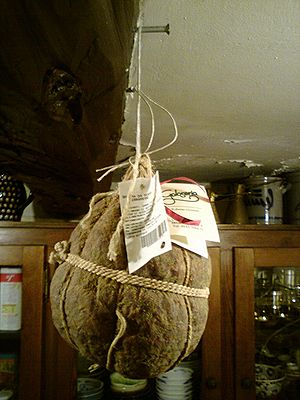Salama da sugo facts for kids
 |
|
| Region or state | Emilia-Romagna |
|---|---|
Salama da sugo is a special kind of salami from the province of Ferrara in Italy. It's made from pork and needs to be cooked before you eat it. This tasty food has special labels like IGP and DOP. These labels mean it comes from a specific place and is made in a traditional way.
Contents
A Look Back in Time
The history of Salama da sugo goes back a long way! A man named Cristoforo di Messisbugo was a steward for Duke Alfonso I d'Este. In 1549, after he had passed away, a book was published with his notes.
This book described how to make "meat mortadelle" using wine in the mix. Many people think this is the first time Salama da sugo was ever mentioned.
How It's Made
Salama da sugo is made by grinding up different parts of a pig. This includes meat from the neck, jowl, and lean parts from the thigh and shoulder. A little bit of tongue and liver are also added.
Today, people add salt, pepper, and nutmeg to the meat. Sometimes, people making it at home might add other spices. These can include cloves and cinnamon. This is a nod to an old recipe from the 1700s by a priest named Don Domenico Chendi.
After mixing the meat and spices, a good amount of strong red wine is added. This wine is not sweet and has no extra chemicals. The wine gives the sausage its special taste and helps it age properly.
The mixture is then put into a pig's bladder. This gives it its unique round shape. The way it's tied creates sections, like slices. After a few days of drying, it ages for about a year. This happens in cool, cellar-like places.
Cooking Your Salama
Cooking Salama da sugo the traditional way takes a lot of effort.
- Step 1: The "Lead Test"
First, you do a check called "piombatura." You put the salama in cold water. If it sinks like a lead weight, it's good! This means no air pockets formed inside while it was aging. If it floats, it might have gone bad.
- Step 2: Getting Ready
Next, soak the salama in lukewarm water all night. Then, wash it under running water. This removes any mold that grew during the aging process.
- Step 3: The Big Cook
You need a tall pot for cooking. The salama must hang freely without touching the bottom or sides. You can use its string, supported by a long wooden spoon across the pot.
Cooking can take from four to eight hours. The time depends on how much fat is in the salama and how long it has aged. As it cooks, some fat comes out, and the meat gets its perfect texture and strong flavor. Unlike other sausages, you should not poke holes in Salama da sugo before cooking.
A fatter salama cooks faster because it loses less water while aging. A salama that has aged longer will need more cooking time. This long cooking makes the salama wonderfully soft.
- Step 4: Expert Care
The long cooking phase is very important and needs someone experienced. The salama must always stay hanging and covered by water. You need to add hot water to the pot whenever needed. An expert also knows exactly how long to cook it.
Pre-cooked Salama
Today, people have less time to cook. Because traditional cooking is so difficult, you can now buy pre-cooked Salama da sugo. This is similar to how you can buy pre-cooked zampone or cotechino.
How to Enjoy It
Salama da sugo is usually eaten hot. You can remove the top part and scoop out the meat with a spoon. Or, you can take off the whole skin and slice it. Make sure to put it in a dish that can catch the delicious sauce that comes out.
The traditional side dish is mashed potatoes. You add a spoonful of the red sauce from the salama to the potatoes. Other side dishes are possible, but they are not as common.
Because it's so filling, Salama da sugo can be a meal on its own. However, sometimes it's part of a big meal with other famous dishes from Ferrara. These might include cappelletti or desserts like pampepato and zuppa inglese.
Ferrara's Special Tradition
Salama da sugo has been a part of Ferrara's food traditions for hundreds of years. The writer Riccardo Bacchelli even mentioned it twice in his book, Il mulino del Po.
Even Renzo Ravenna, who was Jewish, would eat it once a year. The Este Jewish community in Ferrara has even made a special kosher version.
Festivals and Fun Events
There are many festivals celebrating Salama da sugo!
- The "Sagra della salamina da sugo al cucchiaio" happens in late September or early October. It takes place in Madonna Boschi, near Poggio Renatico.
- The "Sagra della salama da sugo di Buonacompra" is held in mid-July in Buonacompra. Also in Buonacompra, "I giorni della salama da sugo I.G.P." is held in mid-October.
- The "World Championship of Salama da sugo" takes place in the second half of February. It's organized in Fiscaglia, specifically in Migliarino.
Special Recognition
In 1722, Antonio Frizzi, a historian from Ferrara, wrote a poem about it called La Salameide.
Salama da sugo is on a list of traditional food products. The Salama da sugo from Madonna dei Boschi even has its own special mention.
On October 24, 2014, "Salama da Sugo" officially became a Protected Geographical Indication (PGI). This means it's a special food from a specific place.
More to Explore



